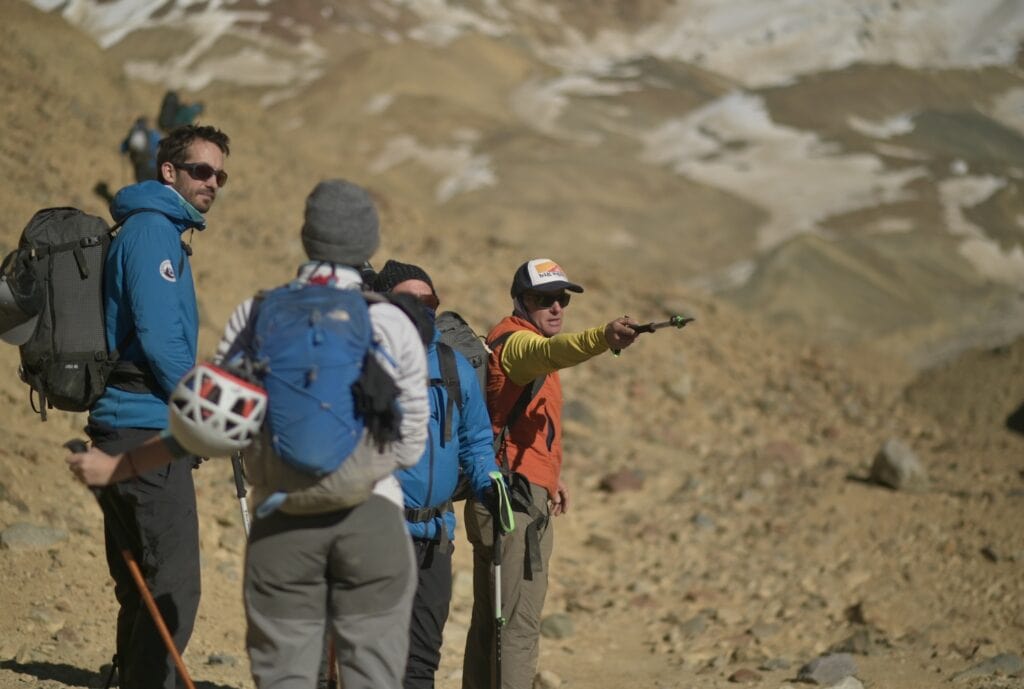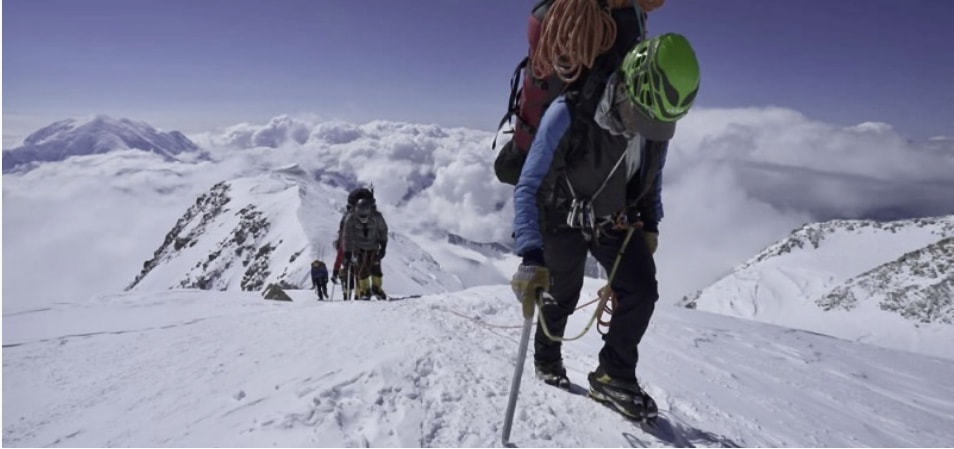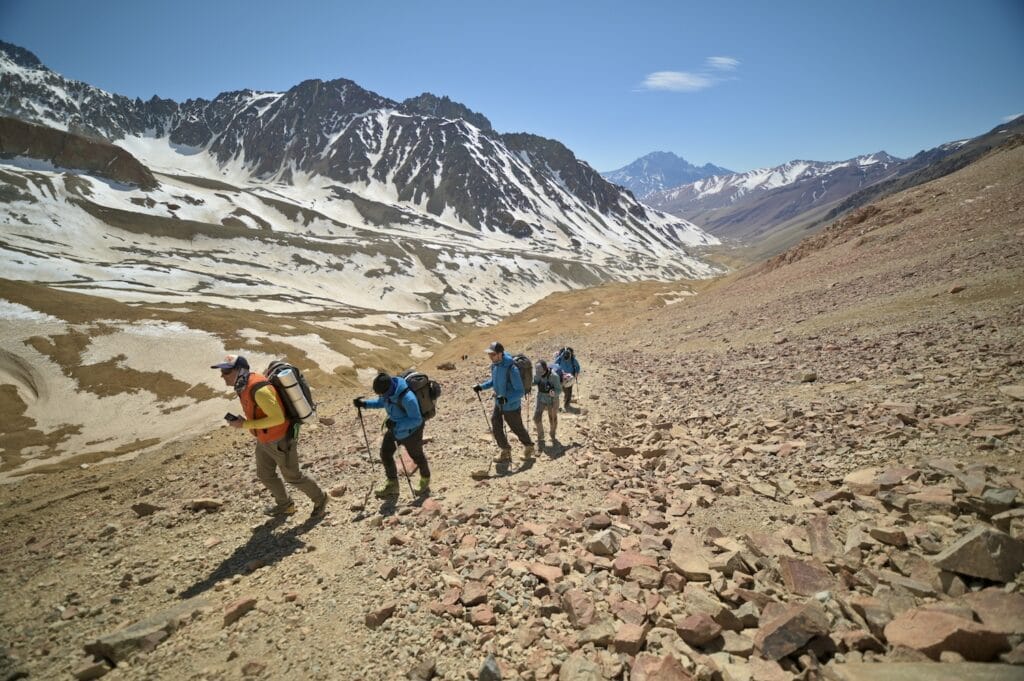7 Tips for Beginner Mountaineers by Legendary Alpinist Willie Benegas

By Owen Clarke
Published on: 03/19/2023
Mountaineering isn’t the easiest sport to break into. It’s expensive, dangerous, physically and mentally demanding, and can only be practiced in certain environments. As a beginner climber, it may seem incredibly daunting to begin a career in the mountains. Unlike a rock climbing gym, you can’t simply “show up” and expect an instructor to tie you in and show you the ropes—much less be able to make it to the top of an easy route and be home in time for dinner. Learning a few beginner tips for mountaineers can go a long way.
About Willie Benegas
When it comes to high-altitude mountaineering, there are few active climbers with a resume as extensive as Willie Benegas (1). The Argentinian has climbed Everest 13 times, and made countless noteworthy first ascents, from big walls on Baffin Island to the 3,000-foot North Face of Pakistan’s Nameless Tower (via an iconic line christened Book of Shadows). He set speed records in Yosemite, and in Africa on Kilimanjaro (19,341 ft) and Mt. Kenya (17,057 ft).

Willie and his twin brother, Damian, have summited South America’s tallest peak, Aconcagua (22,838 feet) over 100 times, and Willie made the first one-day trailhead-to-trailhead climb of the mountain. The pair received Olympic awards for heroism during the Everest avalanches of 2015, and also won a Golden Piton award for The Crystal Snake, a 5,000-foot route up the spectacular North Face of Nuptse (7,861 meters/25,791 feet), a climb I covered for Rock and Ice (2). Willie and Damian are friends of mine, and we recently returned from a trip to Aconcagua together. The pair have been guiding clients for the better part of 35 years, on all seven continents.
So it’s safe to say Willie knows a thing or two about the mountaineering world. Shortly after I got back from Aconcagua, I called Willie up and asked him what advice he had for beginner mountaineers. Here are his seven biggest tips.
1. Follow the Footprints of Others
The first thing to do as a beginner mountaineer is to find a mentor to learn from, someone with more experience than you. It might not be the most unique advice, but this is the most important step you can take when you’re beginning a life in the mountains, says Willie.
“Take a mountaineering class. Hire a guide. Join a club, it doesn’t matter,” he says. “This will give you the basics, and it’s amazing what you’re going to learn naturally while trekking and climbing with people who have more experience than you. You’ll see how your buddy is walking on snow, how he’s navigating boulderfields, how he’s organizing the gear, packing his pack…”
The other benefit of learning firsthand, whether through a guide, a club, or a course, is that it will open a world of connections. Mountaineering alone is never a good idea, so as you begin your new hobby you’ll need to find partners. Joining a club, taking a course, or hiring a guide is the best way to start meeting others in the climbing world.
While firsthand experience is crucial, reading books can augment your training, says Willie. He especially recommends Mountaineering: The Freedom of the Hills. “That’s the Bible, man. That info has been around a long time, verified by true professionals with hundreds and hundreds of hours of training. It’s the most important book you can buy as a new climber.”

Relying on Trusted Sources
Although there’s a wealth of helpful informational content online, Willie says it’s important to be wary. Only trust verifiable sources. “Thousands of people upload YouTube videos about how to do this or that, set up an anchor, and so on,” he says. “Just because it’s on the web doesn’t mean it’s correct. There’s a lot of false information. A certain method may have worked for a certain person, but it could be totally dangerous.”
Willie recalled how, while guiding near Salt Lake City last year, a guy on the route next to him was about to lower off in a way that would’ve made him come completely off-rope. “I called over like, ‘What are you doing? You’re going to kill yourself, man!’ But the guy just said, ‘No, no I saw this method on YouTube, it’s totally fine.’ He would’ve died if I hadn’t stopped him.”
So when looking for tutorials and other info online, look at who’s uploading it and what their background is, says Willie. “If it’s a certified AMGA or IFMGA guide, sure, I would trust that. But look for certifications. Don’t just trust some yahoo.”
2. Train… Hard
Once you begin acquiring the knowledge you need, it’s crucial to train regularly. But you don’t have to live in the Rockies or the High Sierras to train effectively. “Just go behind your house, over to that little hill you never look at,” says Willie, “and start climbing up and down, carrying a heavy pack. It’s that simple. Do it over and over and over.”
Any good aerobic training—activities that work the cardiovascular system like swimming, cycling, running, and hiking—will benefit your climbing. But whenever possible while on the trail, Willie says you should become used to having a backpack on, loaded with weight. “Spend as much time in the field as possible, not on the treadmill,” he says. “In the past, I’d carry my backpack full of water, get to the top on a hill, empty the jugs, and come down. Just simple little things like that, repeated regularly.”

Preparing to Brave the Elements
The second major component of your training, Willie says, should be preparing yourself for adverse weather and conditions. “When your training days are easy, with warm weather and clear skies, life is good. But when you’re on expedition, you can’t control the conditions. Maybe the weather turns bad, or maybe you have to wake up at 1:00 am in sub-freezing temperatures for an alpine start. You need to be trained for this.” So go out and train in all conditions, he advises. Be safe, but don’t cancel your training because of a little rain or cold weather. “The more comfortable you are in all conditions the more you’ll enjoy the adventure, instead of suffering your butt off.”
As they say in the military, learn to embrace the suck.
3. Don’t Forget to Train Your Mind
In addition to training hard physically and learning to push through tough conditions, it’s important to build up mental fortitude. “I warn my Everest clients about this every year,” says Willie. “Maybe they’ve been training regularly, working hard every day… but if the biggest training run they’ve done is four hours, that’s no good, because summit day is 14 hours. They might be in good physical shape, but they won’t have the mental capacity to deal with that 14-hour day, to keep going and going and going.”
So armor your psyche for long, hard days. Prioritize lengthy, slow hikes over short, fast runs. Mountaineering isn’t about speed, it’s about consistency—continuing to move and move and move for hours on end without stopping.
4. Don’t Skimp on Quality Gear
Mountaineering is an expensive hobby, largely because the gear and apparel are so costly. Many novice climbers try to save money by purchasing budget or secondhand equipment that’s either in poor condition or no good to begin with.
Cutting corners isn’t a good idea in a sport as dangerous as mountaineering. “Purchase the gear that allows you to do the job well and stay protected,” Willie says. “You don’t want to get into trouble, maybe injured or killed, because you’re trying to save an extra $50 on a rain jacket.”
The severity of this depends on your goals. If you’re looking at a summer hike of a popular, well-traveled 14,000-foot peak in Colorado, then maybe you can get by with budget gear if you’re willing to accept some discomfort. “It’s harder to hike in cheap sneakers than quality trekking shoes,” says Willie. “But in a low-commitment situation [like a summer 14er], maybe it’s up to you.”
If you go after more technical, remote, or otherwise committing objectives, however, rolling up to the trailhead with low-quality gear can make or break the trip, or even your life.
This doesn’t mean you have to shell out thousands of bucks for world-class equipment. But err on the side of caution. Remember, mountaineering is a demanding and dangerous hobby. “The better, lighter gear you have, the more comfortable you’ll be and the better you’ll be able to perform,” says Willie.

5. Choose Objectives Conservatively
Social media makes it seem like everyone’s an expert, and it can make extremely impressive feats appear commonplace. Don’t be fooled. Choose objectives with caution, says Willie. Take your time to build up to high-altitude summits or technical climbs.
It’s sort of like performing your first lead climb outside. “If you feel you could lead a 5.10, you’d lead a 5.8 or 5.7,” says Willie. “In the same way, you don’t want to go and climb Everest or something else in the Himalaya without experience on smaller peaks in Ecuador, Mexico, and so on. That’s the biggest mistake I see… people choosing objectives for the glory of social media or the “bucket list” rather than suitability and experience.” Several clients died on Aconcagua this season for this very reason.
Sometimes it’s not your ego that can convince you to get in over your head. Many guiding companies—looking to sign as many clients as possible—will encourage climbers to sign on for trips they don’t have the experience for. “Beware the sales page of a guiding company,” says Willie. “They’re trying to sell you something. Don’t skip steps just because someone else thinks your ready.” This is one of the other benefits of having a longstanding relationship with a guide, instructor, or mountaineering club. They can provide an unbiased assessment of whether or not you’re ready to attempt a particular objective.
Not Skipping Homework
“Do your homework,” says Willie. “Study guidebooks. Study trip reports. Set your goals realistically. If your goal is to climb Aconcagua, first do a 14er in the United States. Later, do a mountaineering course in the Cascades. Maybe Rainier. Maybe get some experience winter camping. Do a trip to higher volcanoes in Mexico or Ecuador, like Pico de Orizaba (18,491 feet) or Cotopaxi (19,347 feet). Then check if you’re ready to do Aconcagua.”
Every step in the process is valuable insight, and many lesser-known, lower-elevation summits are far more enjoyable and pristine than the flashy high-altitude peaks that pop up on Instagram. Besides, you have time. One of the benefits of mountaineering is that it truly is a lifetime sport. Many climbers continue well into their 60s and beyond.
“What counts is the process, not the summit.”
6. Choose the Right Partners
Whether you’re climbing with a guide or a partner, choose wisely. After all, “the only difference between a guide and a buddy is the guide is getting paid,” says Willie, “either because they happen to have more experience, or just because the client needs a partner. I see a guide and partner as the same thing.”
There are three key characteristics Willie looks for in a partner: a positive attitude, a safety-first mindset, and a solid level of experience in the mountains. If you’re a beginner, try to find a partner who has at least the same level of experience as you, if not more. You’ll be able to focus on developing your own skills, not hand-holding, and also to attempt objectives that are challenging for both of you, but within your respective comfort zones.
Even when climbing with an experienced guide, never be afraid to ask questions, says Willie. Never surrender your common sense. (I did this years ago on an Ecuadorian 5,000er, and it almost killed me (3)).
Whether guide or client, whoever is erring on the side of caution is always right, says Willie. “If I think it’s too dangerous, we go with my opinion. If you think it’s too dangerous, even if I’m your guide, I will go with your opinion. If you aren’t feeling comfortable, always speak your mind.”
7. Recognize the Risks of Your Environment
The mountains are a world away from your local climbing gym or backyard boulderfield, and the stakes are magnitudes higher. “I recently took my 11-year-old nephew backcountry skiing,” says Willie. “He’s been skiing all his life, but he saw this backcountry terrain and he was ready to ski like we were at the resort slopes. He was all like, ‘I’m going to go hit that jump and do this flip and go right by that tree and do this and that…’ I had to get him to slow down, like ‘No, buddy, we have some [avalanche] danger, I’m going to ski down first, stay to the right of my track, keep no more than a school bus distance away… and so on.’ The little guy was a torpedo, ready to hit everything like he was in a terrain park.”
Each environment has a different level of danger, and “the moment you enter the backcountry, you need to be prepared to protect yourself and get yourself out,” says Willie. “I see lots of people in the outdoors who have never taken CPR or Wilderness First Aid (WFA) courses. That should be a part of anyone’s training. If there’s an accident, you need to be ready.” A broken ankle at the crag behind your house may result in a quick 911 call and a trip to the ER 15 minutes later. A broken ankle on a 16,000-foot peak may lead to frostbite, hypothermia, and death.
Realize that the stakes are higher in the mountains, and act accordingly.
References
Benegas Brothers Expeditions (retrieved on 03/19/2023)
https://benegasbrothers.com/
Forgotten First Ascents: “The Crystal Snake,” Nupste, Nepal, 2003 (retrieved on 03/19/2023)
Owen Clarke, Rock & Ice, July 2020
https://www.rockandice.com/climbing-destinations/forgotten-first-ascents-the-crystal-snake-nupste-nepal-2003/
Imbeciles on a String: An Avoidable Close Call on an Ecuadorian Volcano (retrieved on 03/19/2023)
Owen Clarke, Climbing, Nov 2022
https://www.climbing.com/people/ordeal-in-the-andes/
